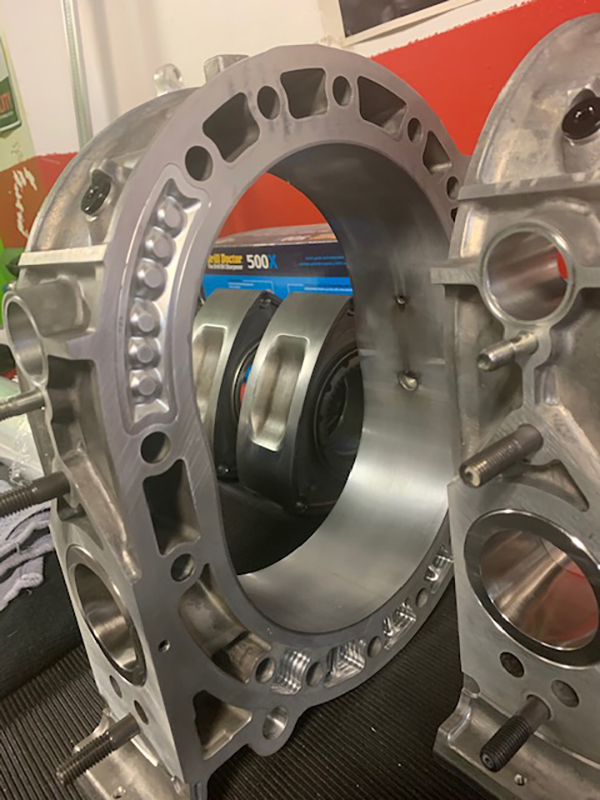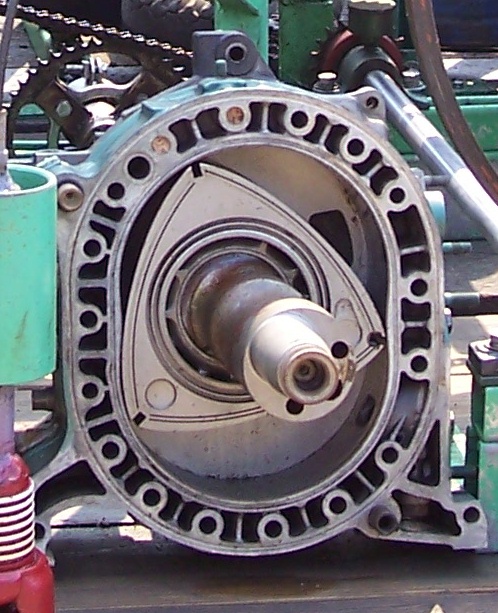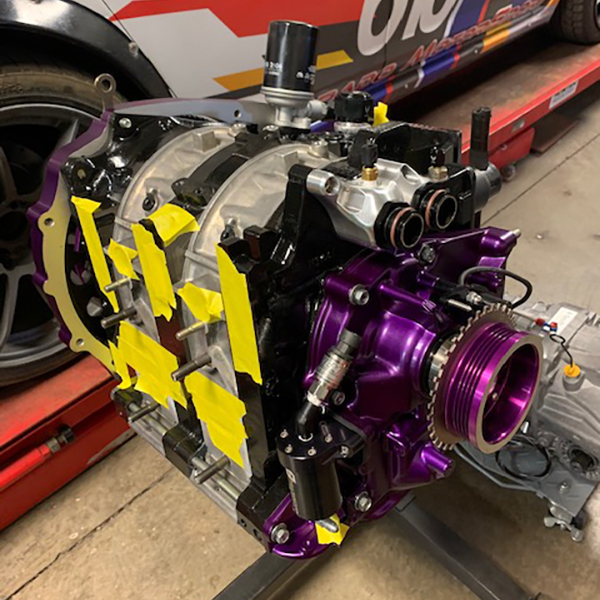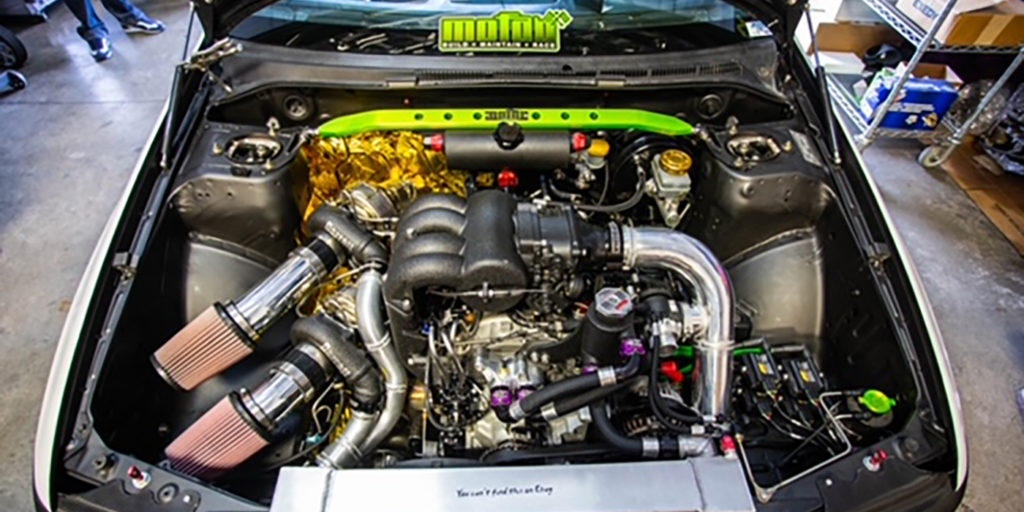With advancements being made in fuel types and engine design, rotary engines have the potential to make a comeback. Global warming, limited quantities of fossil fuels and automotive pollution are current issues that require modern solutions. Rotary engines equipped with advancements may be part of the solution to these problems. A new priority for many car companies is to develop vehicles that have reduced fuel consumption and minimized emissions. Rotary engines have the potential to offer improved performance in these areas over traditional piston-based engines. This article sets out to discuss rotary engines and their advantages and disadvantages, and outlines the engine technology that can potentially allow rotary engines to play a critical role in the future of automotive.
What is a Rotary Engine?
A rotary engine, also known as a Wankel engine, is a type of internal combustion engine that uses a triangular-shaped rotor in an oval chamber as shown in Figure 1. There are three convex faces on the triangular rotor, each of which acts as a piston. The apex of each face has a metal blade that forms a seal with the inner wall of the combustion chamber as shown in Figure 2. The outer housing of the rotor is shaped like an oval, specifically an epitrochoid. This epitrochoidal shape enables the three tips, or apexes, of the rotor to always be in contact with the chamber. These seals create three sealed-off volumes of gas within the chamber.

Each section of the housing is dedicated to one of the four steps of the combustion process: intake, compression, combustion, and exhaust (see figure 1). The housing contains the intake and exhaust ports. The intake port connects to the throttle, and the exhaust port connects directly to the exhaust. There are no connected rods or intake/exhaust valves. The output shaft in a rotary engine has round, eccentrically configured lobes. The rotor pushes on these lobes as the rotor moves through its path within the housing. Due to the eccentric formation of the lobes with respect to the output shaft, the force exerted by the rotor on the lobes produces torque. This causes the output shaft to rotate and generate power.
Advantages of Rotary Engines
One major advantage that rotary engines have over conventional reciprocating piston engines is that rotary engines have a simpler overall structure. A rotary engine has much fewer moving parts compared to a four-stroke piston engine, which includes valves, valve springs, connecting rods, pistons, timing gears, a timing belt, a camshaft, and a crankshaft. On the other hand, a two-rotor rotary engine would only have three moving parts – the output shaft and two rotors. Fewer moving parts in an engine means higher reliability potential.

Another advantage that rotary engines have over piston engines is a smoother running cycle. The moving parts in a rotary engine all continuously rotate in the same direction. Rotary engines also contain counterweights that spin at a certain speed that is vibration-canceling. The pistons in a conventional reciprocating engine vigorously move in different directions. Therefore, rotary engines demonstrate less vibration and smoother overall operation. The smoothness of rotary engine movement is desirable for automobiles and passengers.
An additional advantage of rotary engines is higher engine efficiency compared to piston engines. For instance, a single-rotor rotary engine delivers power for 75% of each revolution of the output shaft. A single-cylinder piston engine delivers power for only 25% of each revolution of the crankshaft. Therefore, rotary engines have a higher power output per combustion cycle. Rotary engines also have a greater mass coefficient, a stronger fuel-air mixture flow, and less maintenance required than piston engines. Rotary engines have a higher power-to-weight ratio than piston engines, so rotary engines are generally lighter and more powerful.

Disadvantages of Rotary Engines
Although rotary engines seem to have many advantages over the conventional piston engine, the drawbacks of traditional rotary engines have prevented their widespread usage. Although the rotary engine was first invented in 1929 by German engineer Felix Wankel, it was not able to take off as a commonly used type of engine due to its poor fuel economy and high levels of pollution. As a result, rotary engines did not gain much popularity in modern vehicles, and the reciprocating piston engine became the main type of engine used.
One major downfall of conventional rotary engines is that they have a high specific fuel consumption. Although they are theoretically more efficient, in practice, rotary engines have higher specific fuel consumption than traditional engines. This is in part due to wear of the apex seals, which prevent the engine cavities from being properly sealed, resulting in leakage of fuel and air from one cavity to the next. Having leaky apex seals is a common problem for conventional rotary engines. This minimizes the maximum pressures and increases the fuel consumption.

Another factor that causes the fuel consumption of rotary engines to be high is long and narrow combustion chambers. The long combustion chamber causes the thermodynamic efficiency of the engine to be decreased. This causes more fuel to be needed by rotary engines than piston engines.
A second main disadvantage is that rotary engines are highly polluting compared to reciprocating piston engines. Rotary engines may have low-grade combustion, which leads to emission issues, especially high carbon monoxide and hydrocarbon emissions. The high levels of greenhouse gas production and toxic emissions of rotary engines are due to several aspects.
One reason is that gas that has not been completely burned could be released from the combustion chamber as hydrocarbons and carbon monoxide emissions. Another reason is that the quenching effect due to the large surface-to-volume ratio of the combustion chamber emits high amounts of hydrocarbons. A third reason is that unburned gas that leaks from the apex seals to the exhaust is a source of hydrocarbon and carbon monoxide emissions.

Although the mechanical design of rotary engines makes it possible to gain higher power density and performance at high speeds, the shape of the combustion chamber and sealing problems of the rotary engine may expel larger amounts of hydrocarbon and carbon monoxide emissions than reciprocating engines.
Reducing the emission levels and improving the fuel economy are the main changes that need to be made to rotary engines in order to facilitate their widespread practical application. In general, the performance of rotary engines deteriorates when it uses liquid fuel such as gasoline. The relatively low flame speed of gasoline and other conventional liquid fuels may cause incomplete combustion due to the long distance that the flame has to travel in rotary engines. The long quenching distance of gasoline in rotary engines also hinders the flame’s ability to reach narrower areas at the rotor ends and wall of the combustion chamber. Unburned hydrocarbon emissions are formed in the wall of the combustion chamber and other cold surfaces due to the quenching effect of the high surface-to-volume ratio on the trailing area of the engine.
As a result, the rotary engine must consume large amounts of fuel. This creates excessive pollutant emissions when it is fueled with gasoline, especially under high speed and load conditions. A promising solution to fix these issues in fuel economy and toxic emissions is to improve the combustion process. The long combustion chamber and the high operating speed of rotary engines requires fuel that has a high flame speed and that can easily be vaporized. Improving fuel properties is a feasible approach for enhancing the performance of rotary engines.
Potential Improvements to Rotary Engines
One way to transform the rotary engine’s drawbacks into advantages is to use hydrogen as fuel. Hydrogen has a low minimum ignition energy (MIE), which means that a very small amount of energy is required to ignite hydrogen in air. The MIE of hydrogen gas in air is only 0.019 mJ, while the MIE of other flammable gasses such as gasoline, propane and ethane is on the magnitude of 0.1 mJ. The ignition energy of hydrogen is even lower in pure oxygen, with the MIE averaging below 0.004 mJ. Hydrogen also has a relatively high flame speed as well, which means hydrogen has the characteristics necessary for good performance in rotary engines. Many of these benefits can be realized through using hydrogen-blended gasoline.
In a study conducted to examine the combustion and emissions of hydrogen-blended gasoline rotary engines, rotary engines supplied with hydrogen-blended fuel were found to perform more efficiently than rotary engines that operated using only gasoline. The brake mean effective pressure, thermal efficiency, cylinder temperature, and combustion pressure of the rotary engine were concurrently increased after the hydrogen volume fractions in the intake were raised from 0% to 5.2%. The use of hydrogen-blended fuel also resulted in a reduction of flame development and propagation periods. The emissions of hydrocarbons, carbon monoxide, and carbon dioxide were all reduced when the hydrogen volume fraction in the intake was increased. When the hydrogen volume fractions in the intake were increased from 0% to 5.2%, hydrocarbon emissions were decreased by 44.8%. This shows that the incorporation of hydrogen into the fuel used for rotary engines may reduce the amount of emissions produced and improve the efficiency of rotary engines.

To maximize the performance of hydrogen-powered rotary engines, the design of triangular rotary engines and elliptical rotary engines should be considered. Triangular rotary engines are traditional Wankel rotary engines which possess a triangular-shaped rotor. Elliptical rotary engines contain a cylinder-shaped rotor, which rotates inside of a cylindrical housing chamber. One study conducted a quantitative investigation to compare the internal flow field properties of triangular rotary engines and elliptical rotary engines. Three-dimensional fluid analysis models were created for each of the two types of engines based on the geometric shape of their rotors. These models were developed using computational fluid dynamics which assumed the fluids to be air and hydrogen, and it neglected thermal effects and combustion for a simpler simulation. A fluid analysis model that simulated the flow of hydrogen through triangular and elliptical rotary engines showed that the gas moment fluctuation coefficient and the flow rate fluctuation coefficient were higher for elliptical rotary engines than for triangular rotary engines. This shows that triangular rotary engines have less fluctuations and are therefore more stable than elliptical rotary engines.
Another advantage that triangular rotary engines displayed in this study was that they were less prone to leakage, had lower energy dissipation, and had reduced exhaust and suction efficiency compared to elliptical rotary engines. Triangular rotary engines also have a simpler fuel flow path and more stable flow than elliptical engines. While the triangular rotary engine was shown to have these advantages over elliptical rotary engines, the elliptical engine did outperform the triangular rotary engine in some categories. For example, the vortex number was found to be higher in elliptical rotary engines than triangular rotary engines, indicating that elliptical engines have higher combustion efficiency. Elliptical engines also produced less exhaust than triangular rotary engines. The benefits and drawbacks of each rotary engine design should be considered when implementing these engines in a real-world application.

One factor that could be altered to improve the performance of rotary engines is the spark plug position. Optimal spark plug position could contribute to making the combustion of rotary engines as efficient as possible with minimal emissions. One study was performed to research the effects of spark plug position on the emissions and combustion of a hydrogen Wankel rotary engine. The two spark plug positions that were tested were the leading spark plug and the trailing spark plug. Due to the complexities of combusting a long chamber, two spark plugs are used in each housing in a rotary engine. The lower spark plug is called the “leading” spark plug, while the top one is called the “trailing” spark plug (see figure 6). The leading spark plug was found to be suited better for hydrogen-fueled Wankel rotary engines than a trailing spark plug. The leading spark plug enabled the rotary engine to have a higher maximum brake torque, better nitric oxide emission, wider range of ignition, and lower cyclic variation.
For instance, the maximum brake torque of the trailing spark plug was found to be 31.2 Nm. This is only 87% of the maximum brake torque of the leading spark plug, which was 36.0 Nm. This shows that the leading spark plug resulted in a braking system with more power. This study also found that adopting the leading spark plug position resulted in higher thermal load and lower cyclic variation than when the trailing spark plug was adopted. Therefore, adopting the leading spark plug position in hydrogen rotary engines will most likely enhance the functional performance of the engine.
Another factor that could be used to improve the current design of rotary engines is spark timing. A study centered around spark timing was able to compare the effects of advanced and delayed spark timing on the operation of a hydrogen-gasoline dual-fuel rotary engine. This study showed that advanced spark timing had multiple advantages. Experimental results showed that for a specific hydrogen volumetric percentage, advanced spark timing resulted in an increased peak combustion pressure and chamber temperature, and brake thermal efficiency was first increased and then decreased. Advancing the spark timing also increased the flame development period and decreased flame propagation period and exhaust temperature. In addition, increasing the advancement of the spark timing also decreased the cyclic variability of the engine. This means that advanced spark timing resulted in less random fluctuations in the flow field of the engine.

One main advantage of delayed spark ignition, however, was that hydrocarbon and nitric oxide emissions were reduced compared to advanced spark ignition. Therefore, these effects would have to be weighed against the overall engine design when developing an advanced rotary engine.
Oxygen enrichment is another way to improve the rotary engine. An increase in the oxygen supplied to the engine’s cylinders has been shown to enhance combustion efficiency and reduce particulate emissions. The addition of excess oxygen to the fuel-air mixture used for combustion within the rotary engine also results in a wider range of flammability, quicker flame speed and increased engine output. These findings were obtained by a study that aimed to investigate the potential improvements in the combustion of a downsized rotary engine through intake oxygen enrichment. The study also found that the presence of oxygen in engine intake air had a strong influence on enhancing burned volume and flame development.
In addition, increasing oxygen enrichment of the engine intake air produced improved peak pressure. This resulted in a rapid combustion period for the engine, which increased combustion efficiency and heat-release efficiency. These improvements also led to a decrease in toxic emissions. There were also substantial decreases in the production of carbon monoxide, soot, unburned hydrocarbons, and nitric oxide when there was a higher-oxygen mixture. This particular study found that an intake oxygen volume of 30% and excess air at a ratio of 1:1 enabled the downsized rotary engine to function at peak performance while minimizing emissions. It is important to consider the optimal oxygen volume and excess air ratio when implementing a rotary engine. To determine what the oxygen volume and excess air ratio should be for a certain rotary engine, the combustion properties and emission levels should be considered.

One successful novel rotary engine design that was developed and tested in 2019 was a small scale opposed rotary piston engine, or ORP engine. This ORP engine utilized the typical four stroke principle. This engine type is promising to achieve lower carbon footprint, reduced noise, smoother delivery of power, and the capability to use multiple fuel types. It was found to have lower exhaust emissions and higher thermal efficiency than normal Wankel rotary engines because the ORP engine design did not have a narrow combustion chamber like typical Wankel engines. The ORP engine has a non-eccentric design, which reduces the idle speed as well as the fuel consumption compared to typical rotary engines and reciprocating piston engines. The ORP engine also has a cylindrical combustion chamber, which resulted in increased brake thermal efficiency and decreased emissions compared to a Wankel rotary engine and traditional piston engines. In addition, this novel ORP engine achieved a higher power output per combustion cycle than Wankel rotary engines and conventional piston engines. The design of this small scale ORP engine is shown in Figure 7.
Implementation of Rotary Engines
To implement the ORP engine design into a real-world application, more research should be conducted to successfully increase the size of the small scale engine design and to determine what factors can increase engine efficiency. The ORP engine is a possible alternative to the current reciprocating piston engines and range extenders used in hybrid vehicles because the ORP engine has all the advantages that a Wankel rotary engine has over reciprocating piston engines while also having higher thermal efficiency and lower emission levels than traditional Wankel rotary engines. The ORP engine also has the potential to be used in hybrid vehicles that use hydrogen as a fuel. Using hydrogen as a fuel in ORP engines would enable hybrid vehicles to have enhanced power output, high combustion and thermal efficiency, and high power density.
Rotary engines can readily be implemented in hybrid architecture, where energy from the engine goes to keep a battery bank charged. For instance, compressed air-electric hybrid vehicles that utilize a compressed air energy storage (CAES) system are a promising application of rotary engines. These compressed air-electric hybrid vehicles are able to convert the vehicle’s kinetic energy through braking to pressurized air. This pressurized air can then be stored in a storage tank in the vehicle to be reused during vehicular operations such as starting, acceleration and cruising. Wankel expanders and compressors could be implemented into such vehicles too.

Wankel rotary engine expanders and compressors are important for power generation of compressed air-electric hybrid vehicles and have been shown to result in a significant reduction in greenhouse gas emissions. Wankel expanders and compressors have many advantages over conventional expanders and compressors. Wankel expanders have increased compactness, lower vibration, reduced noise levels, and a lesser cost compared to traditional expanders and compressors. One study has already created an efficient expander and compressor for a compressed air-electric hybrid vehicle that used a Wankel rotary engine. This study conducted trials that altered the values of parameters such as initial vehicle speed, vehicle weight, braking times, and tank size to test the efficiency of the hybrid Wankel system. The maximum energy-saving efficiency that this Wankel system achieved was around 77%, and an instantaneous system efficiency of 85% was reached.
Hybrid configurations such as CAES systems may implement rotary engines in the near future. Currently, these hybrid configurations, albeit promising, are not used due to the expense associated with the engine and the required aftertreatment. However, given the simplicity of rotary engines and the possible optimization for emissions, a hybrid option using a rotary engine could be financially feasible. In this configuration, the engine would need to operate over limited operating conditions, avoiding the transients that cause issues in hybrid engines. Meanwhile, it offers a lightweight, compact and reliable alternative to conventional engines.
The implementation of improved rotary engines to advanced technologies would have limitless possibilities. Due to their advantages, rotary engines have been considered for use in a variety of applications. Rotary engines have the potential to be used to improve the cruising ability of battery-powered electric vehicles because of their light weight and low vibration. Rotary engines have been used in other applications, such as power saws, compressed air expanders, and motor sleds, and snowmobiles due to their small size and easy start-up at low temperatures.

Rotary engines have been used in production-level vehicles, and they have the potential to become more widespread as newer vehicles are being developed and released. For instance, Mazda has successfully implemented rotary engines in their vehicles since the 1960s. Mazda first developed a Wankel rotary engine-powered vehicle in 1967 when the company released the Cosmic Sport. Nearly half of the company’s car production was powered by Wankel rotary engines in the 1970s, and production-level sports cars such as the RX-7 and RX-8 utilized the renowned Mazda rotary engine. While the RX-8 was discontinued from production in 2012, Mazda has been working to bring rotary engines back in its vehicles. The Mazda RX-Vision concept sports car was unveiled by the company in 2015 and may be brought to production in the future. In addition, the company has recently come out with its 2022 MX-30 EV and plug-in hybrid vehicle. This rotary engine-powered car is currently on the market and available for purchase in Europe and California as of right now.
The 2022 MX-30 is an all-electric vehicle and features a rotary range extender. Even though this vehicle only has an EPA estimated range of 100 miles on a full charge, the production of this rotary-powered electric is an important step towards developing advanced vehicles that run on renewable energy and rotary engines. This marks a significant milestone in the revival of the Wankel rotary engine and the new application of rotary engines in hybrid vehicles. Rotary engines may have the potential to be used in more electric and hybrid vehicles in the future.
Conclusion
An advanced, modern rotary engine would revolutionize the automotive industry. This engine type would enable the development of vehicles that have reduced fuel consumption and minimized emissions. Engines would have a simpler and lighter design while being more powerful. Improvements such as hydrogen fuel, oxygen enrichment, spark plug location, and spark plug timing would allow rotary engines to become more efficient and better for the environment. While reciprocating engines produce less pollution with current technology compared to rotary engines, these advancements could give rotary engines an upper hand. Rotary engines should not be discarded as technology of the past. Rather, they should be improved and used on a wider scale to power more efficient and greener vehicles.
Authors
Dr. Raj Shah is a Director at Koehler Instrument Company in New York, where he has worked for the last 27 years. He is an elected Fellow by his peers at IChemE, CMI, STLE, AIC, NLGI, INSTMC, Institute of Physics, The Energy Institute and The Royal Society of Chemistry.
Dr. Vikram Mittal, Assistant Professor at the United States Military Academy in the Department of Systems Engineering. He earned his doctorate in Mechanical Engineering at the Massachusetts Institute of Technology where he researched the relevancy of the octane number in modern engines. His current research interests include system design, model-based systems engineering, and modern engine technologies.
Ms. Aaliyah Kaushal is a Chemical Engineer student from SUNY, Stony Brook University, where Dr’s. Shah and Mittal are on the external advisory board of directors.











